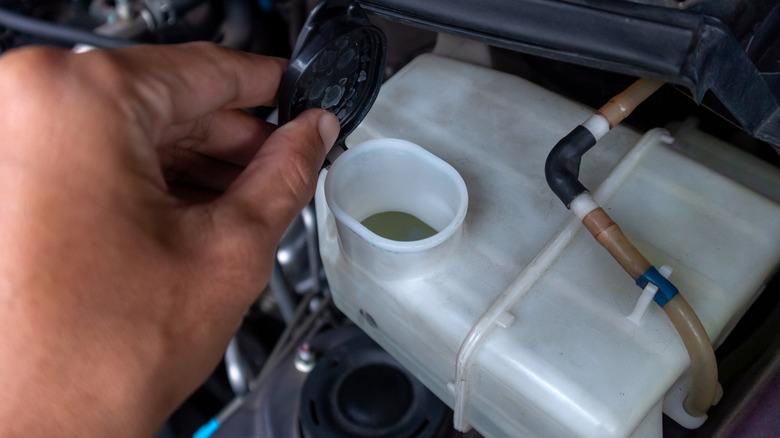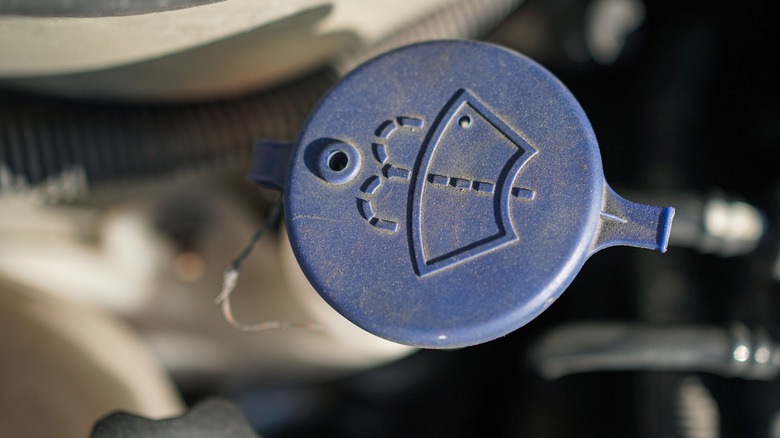Here's How To Drain Your Car's Windshield Wiper Fluid
It might seem unusual to drain a vehicle's windshield washer fluid, but there are legitimate reasons why this is an essential maintenance activity. I experienced this firsthand last year with a Ford Mustang I purchased at auction. The car arrived with a wiper fluid reservoir filled with what looked like water. In preparation for the upcoming winter, I emptied the solution and replaced it with a more suitable blend. Had I not, the water could freeze and expand in the cold, causing damage to a system made mostly with plastic. Even some types of regular wiper fluid can freeze. I'm not a mechanic, but I've owned and worked on numerous used and auction cars over the years, so I've learned that fluid checks are a vital first step.
There are other scenarios where emptying the wiper fluid reservoir is necessary. Changing from a summer-friendly solution (with insect removal agents) to a winter-specific formula (with methanol to protect against freezing), or vice-versa, is common. Meanwhile, someone not paying attention or unfamiliar with what's going on under the hood could add the wrong liquid (think coolant). There may also be a need to remove contaminated wiper fluid to prevent damage to the pump or spray nozzles. Replacing the wiper fluid pump or supply line can require draining the wiper fluid to avoid waste and contamination.
Siphoning is the easiest way to extract wiper fluid; the steps are covered below. However, there are other methods, which are explained in the last section. In short, it's not too hard to find a way to drain wiper fluid when the need arises.
Draining wiper fluid the easy way: siphoning
Even if you're not the DIY type, there are a few essential vehicle maintenance tools to have on hand. One is a siphon pump. Whether you need to transfer gasoline, coolant, or wiper fluid, these handy devices can help. A basic manual siphon comprises two tubes connected with a squeezable bulb and costs under $10. Alternatively, a drill pump swaps the bulb for a housing with an internal impeller. The unit, which sells for about $25, is connected to a drill that powers the pump. Either will work fine for draining wiper fluid. Never siphon by mouth; ethanol and other additives in store-bought washer fluid are toxic.
Here's how to drain wiper fluid with a manual siphon or drill pump:
- Set up: Gather a bulb-style manual siphon pump or a drill pump, along with a container to collect the fluid. Wear waterproof gloves to prevent contact with the fluid. Make sure the car is off and the engine is cool.
- Locate the reservoir: Open the hood and identify the wiper fluid reservoir (check the owner's manual, if needed). Remove the reservoir cap.
- Insert the intake tube: Drop the intake hose inside the reservoir, ensuring the end reaches the bottom.
- Place the outlet hose: For the manual siphon, insert the outlet hose end into the container. The container must be lower than the reservoir for gravity to help the fluid flow. Placement isn't a factor with a drill pump, but the container should be stable.
- Pump the fluid: For the manual siphon, squeeze the bulb until the fluid flows. If using a drill pump, attach it to the drill and operate at a slow speed to move the fluid.
- Finish: Completely drain the fluid, seal the container, and dispose of the liquid at a recycling center, not down the drain.
Other ways to drain wiper fluid
While siphoning is arguably the easiest way to drain wiper fluid, it's not the only method. One approach is to disconnect the line running from the reservoir to the spray nozzles. Reroute the hose from the nozzles into a container, and then activate the washer function until the tank is empty. Don't overwork the pump by running it dry. You may think, "Why not just spray wiper fluid through the nozzles until the reservoir is empty?" Yes, this is an option, but not an environmentally friendly one.
Depending on the car, you may be able to take advantage of gravity draining. Some vehicles have a reservoir with a hose connection, plug, or sensor port at the bottom that can be opened to empty the fluid. Use a pan or basin underneath to capture the liquid, and dispose of it properly. Don't let wiper fluid absorb into the ground.
While removing the reservoir isn't the easiest way of draining washer fluid, it's still an option. This may also be the best technique if the tank has contaminants that could block the lines and nozzles. The typical reservoir is secured with a few bolts and clips and has electrical connectors for the pump and the fill sensor. However, some tanks are buried in the engine bay, requiring the removal of the fender liner and other components for access. Once the reservoir is removed, the fluid can be poured out for safe disposal. With everything back together, you can make your own washer fluid.


